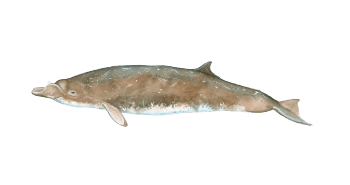
Blainville’s beaked whale
(Mesoplodon densirostris)
Blainville’s beaked whales are widely distributed, inhabiting temperate and tropical waters of all major oceans. Like all beaked whales, Blainville’s prefer deeper waters but around some oceanic islands, like Madeira, they can be seen more inshore than other beaked whales.
Their lower jaw has a strongly arched mouthline at midlength making it more easy to recognise. Adult males have two erupted teeth in the upper jaw are often covered with goose barnacles.
The jawbone itself is denser than elephant ivory and for this reason the species is also known by some as the “dense-beaked whale”.
Blainville’s occurs in small groups of up to seven individuals that can often be considered as harems.
General information
Further names: Portuguese: Baleia-de-bico-de-Blainville; English: Dense beaked whale
Size of adults: Males: 4,7 m; Females: 4,6 m
Prey: Squid and mesopelagic fish.
Behaviour: Animals dive approximately every two hours to depths of up to 700 m to hunting deep sea squid. Such dives can last up to 50 minutes.
Range: Temperate and tropical waters of all oceans.
Madeira: Occur all year around; often in small harem groups with several females in the company of one bull.
Distinctive features: Robust body, containing a characteristic yellowish tint due to a parasite. Their small and flat forehead (melon) extends into a long beak with distinctive arched mouthline. They have a relatively small, triangular dorsal fin, set far back towards the fluke. The bodies of males are often covered with scars (some of which are circular, believed to be made by the cookie-cutter shark) and white spots. They surface with their beaks pointing up and emit a small spout.
Taxonomy: Suborder: Odontoceti (Toothed Whales); Family: Ziphiidae (Beaked Whales)
Threats: Noise pollution leads to an increase in mass strandings of these acoustically sensitive creatures. The most recent report on standings due to acoustic trauma was in September 2002 when 14 dead whales were washed ashore in Fuerteventura shortly after naval military excercises were conducted in the area. Are also popular victims of plastic pollution and bycatch. Their global population size is unknown.
